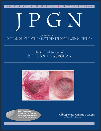Epithelial Electrical Resistance as a Measure of Permeability Changes in Pediatric Duodenal Biopsies
ABSTRACT
Objectives:
Intestinal permeability measured with medium-sized oral probes is increased in cystic fibrosis (CF) and celiac disease (CD), probably reflecting reduced tight junction resistance. The aim of this study was to evaluate whether square-pulse analysis of duodenal biopsies from children can be used to determine electrical tight junction resistance.
Methods:
Intestinal biopsies from children with different stages of CD and from patients with CF were studied in a modified Ussing chamber. The epithelium was assumed to act as an electrical circuit consisting of a current generator parallel with a resistance and a capacitance. Subepithelial and epithelial resistances were determined by square-pulse analysis, and the generated current was calculated.
Results:
Confirming data using permeability probes, reduced epithelial electrical resistance was found both in patients with CF and CD. Only the CF patients had reduced resting current as well. The secretagogues prostaglandin E2, cyclic adenosine monophosphate and acetylcholine increased the current in both control biopsies and biopsies with villous atrophy but had no significant effect on epithelial resistance.
Conclusions:
Measurement of electrical resistance in duodenal biopsies can be used as an alternative method of quantifying permeability in pediatric biopsies.




